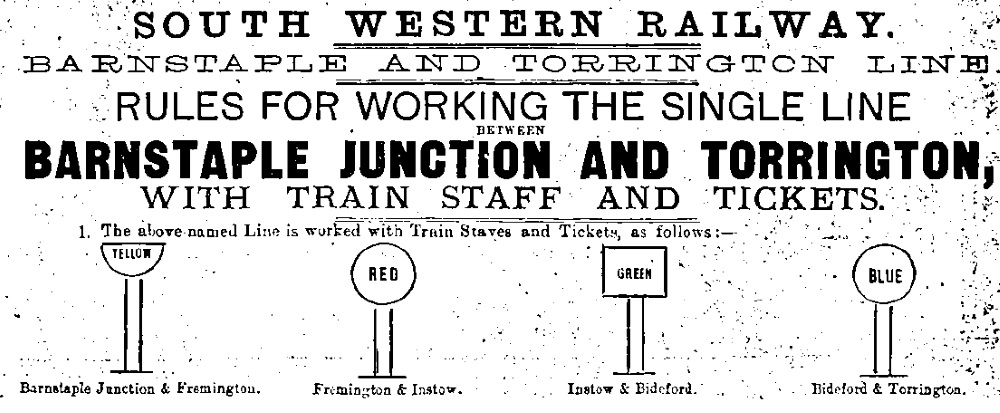| Register of Single-Line Sections and their methods of working |
|||
|
This is a Register of Single-Line Block Sections on the railways of the UK West Country. The Register has been divided into separate sections for the former Great Western Railway, London & South Western Railway / Southern Railway, Somerset & Dorset Joint Railway and various minor railways. For quick access to the details of any individual line please click the appropriate entry in the Index below.
Please Note: with a few exceptions most goods-only lines are not included yet in the Register, but it is hoped to add them as more information becomes available. Most of the railways listed in the Register have been closed, but for those lines which remain open under Network Rail there is a Current Lines page which covers the period from about 1970 onwards. The Register does not cover any private 'heritage' railways.
For general background information about the block working of single-line sections, please read the RailWest Introduction to Single-Line Block Working page.

An extract from London & South Western Railway Instruction 83 of 1892
The RailWest Register lists the method of working, configuration of equipment and dates of use (where known) for each single-line section. However the Register will not be a complete record for all single-line sections which ever existed in the West Country, as it would be virtually impossible to collate or present all that information in a useable format. Many main lines were built originally as single-track and then were doubled in stages over the years, a process which lasted for example on the Great Western Railway in Cornwall until the early part of the 20th Century. The Register therefore, with a few exceptions, will concentrate on those branch and secondary lines which were primarily single-track for most of their existence.
The Register was compiled originally to provide details for the period from about 1900 onwards, but there is ongoing work to include details for earlier periods as and when relevant information becomes available. However it is not intended to extend the Register's coverage much further back than about 1870, as the earliest methods of controlling single-lines usually relied simply upon the use of such things as telegraph instruments and written orders, whereas the Register is designed primarily to record the physical staffs, tablets or tokens which were the prevailing characteristic of the operating methods used in later years.
It is important to appeciate that the method of working and the type of equipment in use on any single-line section may have changed over the years. Similarly on lines with more than one single-line section it was not uncommon for a mixture of equipment types to be in use on different sections. Much of the original information for the Register was taken from records of the British Railways period after 1948, so in many cases the method of working may have been changed at least once beforehand; for example, many of the sections listed as being worked by EKT would have been ETT or ETS before that and perhaps even TS&T originally. Furthermore, from about 1960 onwards it became the practice to use the term 'token' as a generic description for a staff, tablet or key token regardless of the actual physical type, but as far as possible the entries in this Register will make the appropriate historical distinction.
The actual block sections themselves sometimes changed as signal-boxes were closed or new ones were opened. This situation became more common from the 1950s onward, as lines were rationalised prior to closure and the numbers of signal boxes (and hence block sections) declined rapidly. Conversely several new sections appeared as parts of some double-track lines were reduced to single track in order to save on maintenance costs. However many of those new sections fell completely within the control of one signal box and therefore were not worked by any of the 'traditional' methods.
The Register does cover a few lines which, although predominately single track, did include a small number of double-track sections (often at one or both ends). These double-track sections may be listed in the Register in order to complete the overall picture of the whole line, but any information about their block working or equipment has been excluded. In cases where the length of double-track spanned more than one block section then the intermediate signal-boxes may not be listed unless included for clarity.
Because of the fragmented nature of the available historical records it has not been possible in all cases to determine the precise year of any particular change of block section and/or method of working. As far as possible 'best endeavours' have been made in such cases to provide an 'educated guess' about the chronological history, but there may be some instances where the Register has no entry for a section which only existed for a short period of time with a particular method of working. Similarly there may be instances in the Register where one part of a line is recorded in greater or lesser detail than another part. This is regretted, but it is hoped that it does not detract from the overall value of the Register as a reasonably comprehensive research record. Explanatory notes have been added to various entries in the Register as necessary.
© CJL Osment 2017-24
| West Country Single Lines Register Pages | |||||
|---|---|---|---|---|---|
|